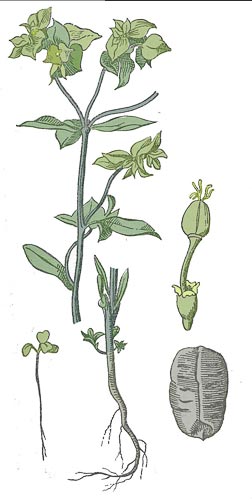Weeds
Euphorbia falcata L. - Crescent Spurge
Systematic position.
Family Euphorbiaceae, genus Euphorbia L. (Tithymalus Gaertn.); 202 species of Euphorbia grow in the former USSR.Synonyms.
Euphorbia acuminata Lam., E. falcata acuminata (Lam.) Simonk., E. galilaea Boiss., E. tatianae Al.Theod., E. obscura Loisel., E. pseudograeca Grossh., Tithymalus falcatus (L.) Klotzsch et Garcke, T. falcatus acuminatus (Lam.) Sojak, T. acuminatus (Lam.) Prokh.Biological group.
Annual plant.Morphology and biology.
Annual, glabrous, glaucous plant with plentiful branching upright stalks, 5-20 cm tall. Plants contain white lacteal juice. The stalk has 1 to 7 axillary peduncles (1-5 cm long) above and sometimes short, non-blossoming branches below. Phyllotaxy is alternate. Leaves soft, without stipules. Stem leaves are 2-7 mm wide and 1-3 cm long, short-petiolar, with clinoid base (the same as involucral leaflets), with the greatest width in the upper third, entire or finely dentate. Upper peduncles are 3-4 in number, 1-4 cm long, repeatedly bipartite at top (similar to axillary peduncles). Flowers fine, inconspicuous, unisexual and greenish-yellow. They are aggregated also in the complex inflorescence. The latter includes some male flowers consisting of single stamen and one female flower with an ovary (capsule). Pistillate female flower and staminate male flowers are wrapped by cup-shaped cover leaf having lobes and glands (nectaries). Involucral leaflets are bent downward, inversely-lanceolate or oblong, 3-5 mm wide, 1-2.5 cm long, with the greatest width in the upper part, sharp and frequently peaked. Bracts are two, rising from the rounded or heart-shaped base; they are ovoid, thin, peaked; lower bracts are 5-10 mm wide, 8-20 mm long, with serrate margin. Cup-shaped cover leaf is campaniform, 1-1.5 mm wide, glabrous outside and fluffy inside. Glands (nectaries) are semi-lunar, truncated at the base, reddish, extended in long horns, without appendages. Their length does not exceed their width. Columns are 1-1.5 mm long, free, deeply bifid. Fruit is ovoid three-cell nutlet or boll, greenish, about 2.5 mm long, deeply three-furrowed, glabrous and smooth. Seeds are oval, compressed, 1-2 mm long, with a spherical-conic appendage, and with a rough surface (having several transversal grooves). Their color is glaucous, yellowish, and brown. Blossoming occurs in May-July.Distribution.
The species was described from Europe (Switzerland). The type plant was imported to Paris. The general distribution includes Southern and Middle Europe, the Mediterranean, Northern Africa, the Balkans, Asia Minor, Iran, Afghanistan, India and the Himalayas. In the territory of the former USSR it is found in the southern and middle areas of the European part, in Crimea, the Caucasus, and mountain areas of Central Asia. It is as adventive plant in the Far East.Ecology
The species is distributed in semi-desert, forest-steppe and steppe zones. It is a Xeromesophyte. Natural habitats in the Caucasus include foothills and dry slopes. In other regions it grows in anthropogenic ruderal and segetal habitats, i.e., in garbage places, kitchen gardens, crops, fallow lands, along roads and railways. This plant is widely distributed across the Earth.Economic significance.
Insignificantly litters crops in southern areas of the European part, in the Caucasus, and in the south of Central Asia. Occasionally found in dry grain crops, and also in irrigable crops of wheat and cotton. As a weed it has low significance. Since no literature references specify this species as a malicious or important weed in the territory of the former USSR, we did not determine an area of weediness for this species. Control measures are the same as against any other annual weed. Do not contaminate sowing material or ground with seeds of the weed. Mow off or pull up the weed before fructification. It is necessary to remember that good results in controlling the weed can be only achieved with a combination of agronomical and chemical methods.Reference citations:
Keller B.A., Lyubimenko V.N., Maltsev A.I., Fedchenko B.A., Shishkin B.K., Rodzevich R.Yu., Kamenskii K.V., eds. 1934. Weed plants of the USSR. Moscow-Leningrad: AS USSR. V. 3. 448 pp. (In Russian)Nikitin V.V. 1957. Weed vegetation of Turkmenia. Ashkhabad: AN Turkmen SSR. 581 pp. (In Russian)
Nikitin V.V. 1983. Weed plants of the USSR flora. Leningrad: Nauka. 454 pp. (In Russian)


